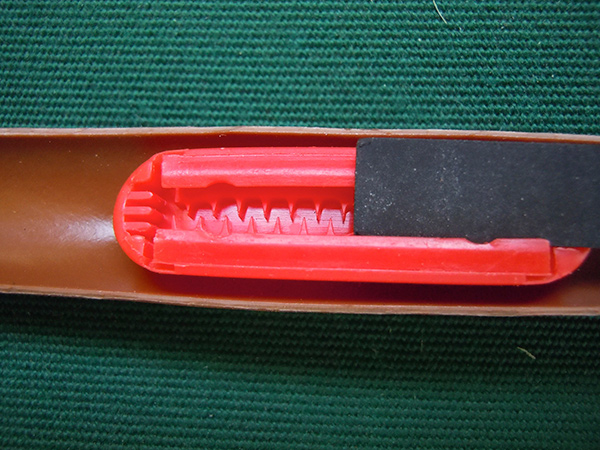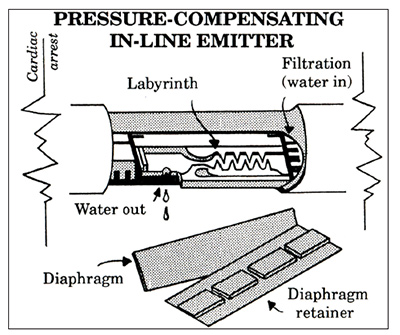Using in-line drip irrigation tubing is the most elegant system to install. Simple roll out the tubiing , flush and cap. No arm twisting, hand stressed punching in of emitters. When you first price the tubing, you might think it is expensive. But it is actually about half the cost of punched in emitters and the solid tubing. In 2011 pricing, a 100-foot roll of in-line tubing with 1/2-gph emitters (pressure compensating for the most even water distribution) installed every foot costs about $32. A 100-foot roll of solid one-half-inch tubing cost is around $17. One hundred punched emitters (also with pressure-compensating emitters) costs $44 dollars. So, in-line equals $34, while punched-in emitters equals $61! (That’s one reason the irrigation stores push punched-in emitters so much.)

The internal emitters utilize what is known as a “tortuous path” the water must pass through a labyrinth of right-angled channels inside the emitter before exiting via a hole much larger than that of a typical punched-in emitter. The tortuous path causes the water to form a continuous vortex, a kind of horizontal tornado, which keeps any sediment, sand or silt in suspension so it won’t settle out and clog the emitter. I used in-line emitters for Chester Aaron’s 60 raised beds of garlic 25 years ago. Even with well water full of iron oxide [notorious for clogging regular punched-in emitters], I’ve found only a few clogged emitters in a thousand feet of tubing. Another person I know actually took off the filter and pressure regulator for four years and found no clogged emitters compared to the filter and pressure regulator assembly they originally installed. A true testimony to the cleaning action of these emitters.

The emitters come pre-installed in tubing with 12-, 18-, 24-, and 48-inch spacings [they can be custom ordered at just about any interval— for an extra fee], but the type most commonly sold to gardeners is the 12-inch interval. The emitters inside the hose are rated to dispense either 1/2- or 1-gph [actually 0.6 and 0.92 gph]. The cost ranges from $22 to $32 for a 100-foot roll depending on the emitter [its flow rate and whether or not it’s pressure compensating.] Newer versions include tubing with pressurecompensating emitters at the same intervals as in the noncompensating in-line tubing and with 1/2- or 1-gph flow rates. [See the photo of the exposed red pressure-compensating emitter in the tubing.] I always use the kind with 1/2-gph emitters on 12- inch centers because they will irrigate, depending upon how long the system is left on, both sandy and clayey soils. The benefits of in-line pressure-compensating emitters are: they are very easy to install, simple to snake around your existing plantings, suffer less clogging than porous tubing and some punched-in emitters, provide consistent rates of irrigation without regard to slope or length, have no external parts to snap off, their connectors or fittings don’t leak, and the connectors, either compression fittings or Spin-Loc™ fittings, seal better than metal hose clamps with porous hose
Much of this “newer” technology is available from suppliers to the commercial landscape trade. [See your local Yellow Pages.] |

